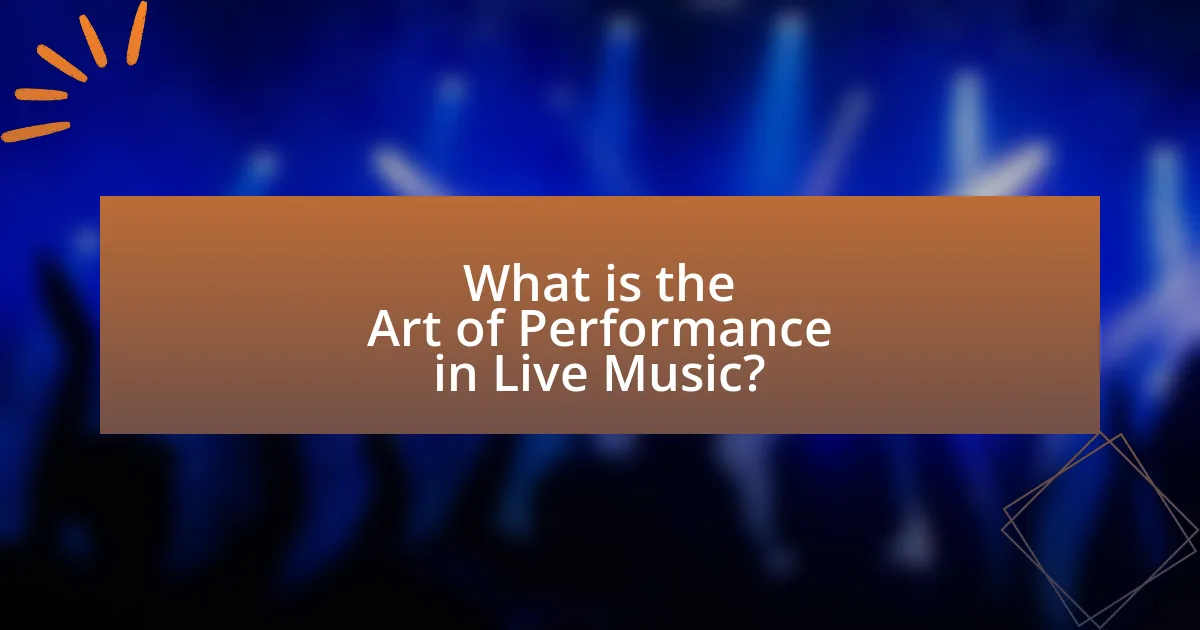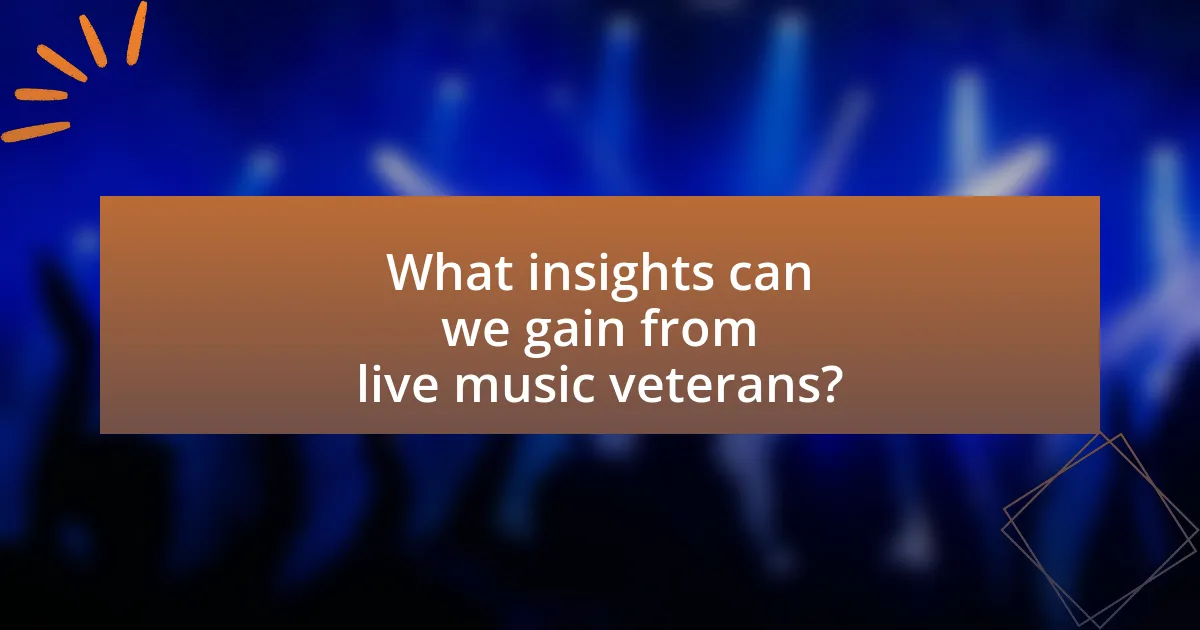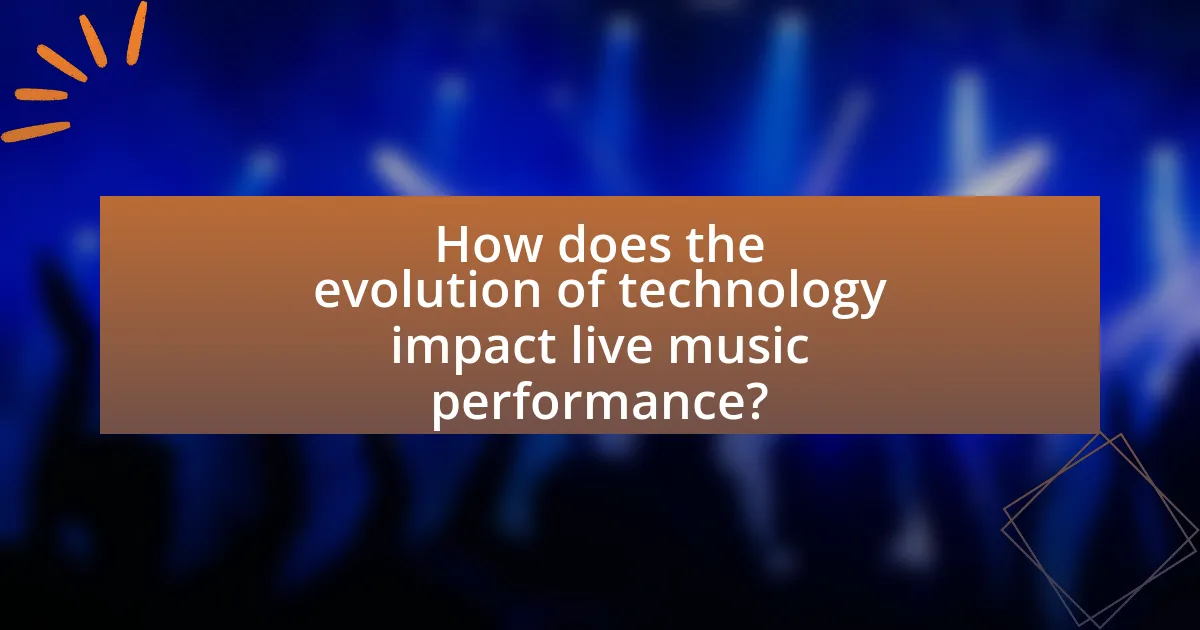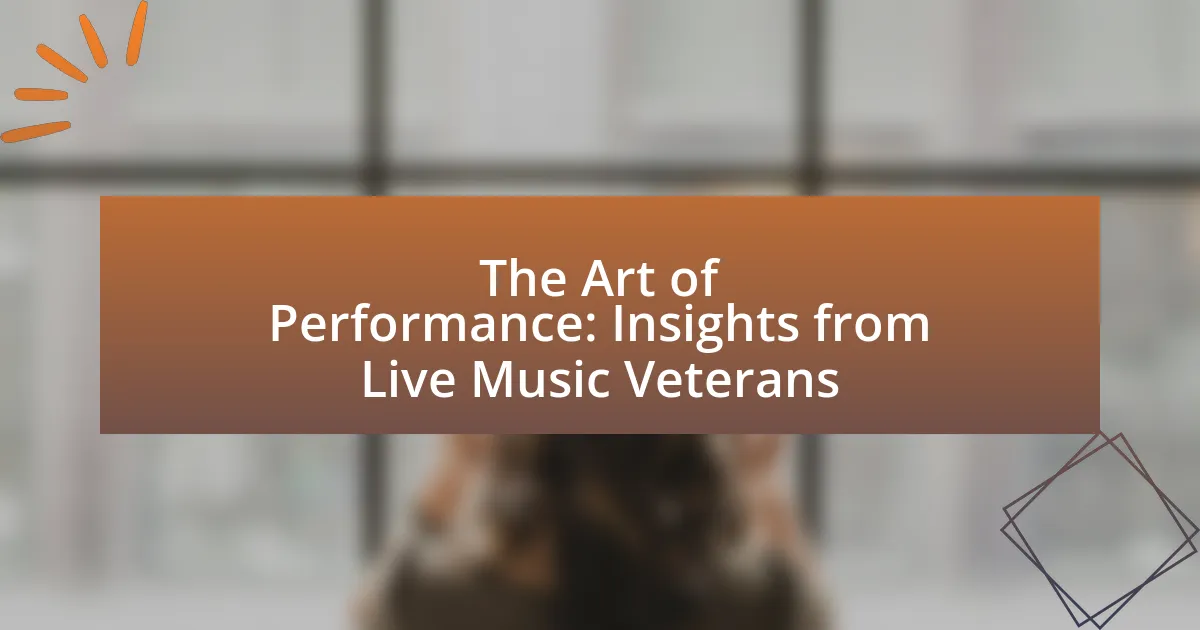The main entity of the article is the Art of Performance in Live Music, which encompasses the skillful execution and presentation of musical works to create emotional connections with audiences. The article explores how live music veterans define performance art, the essential elements that contribute to compelling performances, and the significance of audience engagement. It also examines the historical influences on live performance, the impact of technology, and the challenges faced by performers, particularly veterans. Insights from experienced artists highlight the importance of resilience, adaptability, and collaboration in developing a unique performance style and connecting with audiences effectively.

What is the Art of Performance in Live Music?
The Art of Performance in Live Music refers to the skillful execution and presentation of musical works in front of an audience, emphasizing emotional connection, stage presence, and audience engagement. This art form involves not only technical proficiency on instruments or vocals but also the ability to convey emotions and narratives through performance. Historical examples, such as the electrifying stage presence of artists like Jimi Hendrix or the theatricality of Queen, illustrate how performance can elevate music beyond mere sound, creating memorable experiences for audiences. The effectiveness of live performance is often measured by audience reactions, ticket sales, and critical acclaim, underscoring its significance in the music industry.
How do live music veterans define performance art?
Live music veterans define performance art as a multifaceted expression that combines music, visual elements, and theatricality to create an immersive experience for the audience. This definition emphasizes the integration of various artistic disciplines, where the live performance transcends mere musical execution to engage viewers on emotional and intellectual levels. For instance, artists like David Bowie and Madonna have historically blended music with elaborate stage designs and storytelling, illustrating how performance art can challenge traditional boundaries and provoke thought.
What elements contribute to a compelling live performance?
A compelling live performance is primarily driven by strong stage presence, audience engagement, and high-quality sound production. Strong stage presence captivates the audience, as performers who exude confidence and charisma can create a memorable experience. Audience engagement is crucial; interactive elements, such as call-and-response or inviting audience participation, foster a connection that enhances the overall enjoyment. High-quality sound production ensures that the music is delivered clearly and powerfully, allowing the audience to fully appreciate the performance. Research indicates that these elements significantly impact audience satisfaction and retention, as evidenced by studies showing that performances with high engagement levels lead to increased positive feedback and repeat attendance.
How does audience engagement shape the performance experience?
Audience engagement significantly shapes the performance experience by influencing the energy and interaction between performers and the audience. When audiences actively participate, such as through clapping, singing along, or responding to cues, it creates a dynamic atmosphere that enhances the emotional impact of the performance. Research indicates that high levels of audience engagement can lead to increased satisfaction and a memorable experience, as evidenced by a study published in the Journal of Music Therapy, which found that engaged audiences reported higher levels of enjoyment and connection to the performance. This interaction not only motivates performers but also fosters a sense of community among attendees, further enriching the overall experience.
Why is performance considered an art form?
Performance is considered an art form because it combines creativity, expression, and technical skill to convey emotions and narratives to an audience. This artistic expression is evident in various forms, such as theater, dance, and live music, where performers utilize their bodies, voices, and instruments to create a shared experience. Historical examples, such as the theatrical works of Shakespeare or the improvisational styles of jazz musicians, illustrate how performance transcends mere entertainment, engaging audiences on emotional and intellectual levels. The ability of performers to evoke feelings and provoke thought through their craft solidifies performance’s status as a legitimate art form.
What historical influences have shaped the art of live performance?
The art of live performance has been shaped by various historical influences, including ancient rituals, theatrical traditions, and cultural movements. Ancient Greek theater, for instance, established foundational elements of performance, such as scripted dialogue and audience engagement, which are still relevant today. The Renaissance period further influenced live performance through the revival of classical arts and the emergence of opera, blending music and drama. Additionally, the rise of jazz in the early 20th century introduced improvisation and spontaneity, transforming the dynamics of live music. These historical contexts illustrate how live performance has evolved, integrating diverse cultural expressions and artistic innovations over time.
How do cultural contexts affect performance styles?
Cultural contexts significantly influence performance styles by shaping the artistic expressions, audience expectations, and the overall aesthetic of performances. For instance, in traditional African music, communal participation and call-and-response patterns are prevalent, reflecting the cultural emphasis on community and collective experience. In contrast, Western classical music often prioritizes individual virtuosity and structured compositions, which aligns with cultural values of individualism and formal education in the arts. Research indicates that these cultural frameworks dictate not only the technical aspects of performance but also the emotional engagement and narrative styles employed by artists, as seen in studies like “Cultural Influences on Musical Performance” by John Blacking, which highlights how cultural background informs the interpretation and delivery of music.

What insights can we gain from live music veterans?
Live music veterans provide insights into the nuances of performance, audience engagement, and the evolution of musical styles. Their extensive experience reveals that successful performances rely on understanding audience dynamics, as veterans often adapt their setlists and stage presence based on crowd reactions. For instance, a study by the University of Southern California found that live performers who engage with their audience can increase overall satisfaction and connection, leading to a more memorable experience. Additionally, veterans emphasize the importance of resilience and adaptability in the face of challenges, such as technical difficulties or unexpected changes in venue conditions, which are common in live settings. This adaptability is supported by historical examples, such as the improvisational skills displayed by artists like Miles Davis, who often altered performances in real-time to enhance the experience.
What common challenges do veterans face in live performances?
Veterans commonly face challenges in live performances such as anxiety, PTSD symptoms, and difficulties with social interaction. These issues can stem from their military experiences, which may lead to heightened stress levels in public settings. Research indicates that approximately 20% of veterans experience PTSD, which can manifest as panic attacks or overwhelming anxiety during performances. Additionally, veterans may struggle with reintegration into civilian life, affecting their confidence and comfort on stage. These factors collectively hinder their ability to perform effectively in live music settings.
How do veterans overcome performance anxiety?
Veterans overcome performance anxiety through a combination of preparation, mental conditioning, and support systems. They often engage in extensive practice to build confidence and familiarity with their material, which reduces anxiety during performances. Additionally, many veterans utilize techniques such as visualization and mindfulness to manage stress and focus their thoughts. Research indicates that structured rehearsal and positive self-talk can significantly enhance performance outcomes by mitigating anxiety. Furthermore, support from fellow musicians and mentors provides emotional reassurance, creating a collaborative environment that fosters resilience against performance-related stress.
What strategies do veterans use to connect with their audience?
Veterans in live music utilize several strategies to connect with their audience, including storytelling, emotional engagement, and audience interaction. Storytelling allows veterans to share personal experiences and narratives that resonate with listeners, creating a deeper emotional connection. Emotional engagement is achieved through the delivery of music that evokes feelings, often drawing from their own life experiences to enhance authenticity. Additionally, audience interaction, such as inviting participation or responding to crowd energy, fosters a sense of community and inclusivity, making the performance more memorable. These strategies are supported by research indicating that emotional storytelling can significantly enhance audience engagement and retention in live performances.
What lessons can emerging artists learn from veterans?
Emerging artists can learn the importance of resilience and adaptability from veterans in the music industry. Veterans often emphasize the necessity of overcoming challenges and setbacks, as evidenced by numerous artists who faced initial rejections before achieving success. For instance, artists like Madonna and J.K. Rowling experienced multiple rejections before their breakthrough, highlighting that perseverance is crucial. Additionally, veterans teach emerging artists about the significance of building a strong network and maintaining relationships within the industry, which can lead to collaborative opportunities and support. This networking aspect is supported by studies indicating that 70% of jobs are found through networking, underscoring its value in an artist’s career.
How can new artists develop their unique performance style?
New artists can develop their unique performance style by experimenting with various genres, techniques, and stage personas. This experimentation allows artists to discover what resonates with their identity and audience. For instance, artists like Lady Gaga and Prince have successfully blended different musical styles and theatrical elements to create distinctive performances that reflect their individuality. Engaging in regular practice, seeking feedback from peers, and analyzing performances of established artists can further refine their style. Research indicates that artists who actively engage in self-reflection and audience interaction tend to develop a more authentic performance style, as seen in studies on performer-audience dynamics published in the Journal of Arts Management, Law, and Society.
What role does collaboration play in live music performances?
Collaboration is essential in live music performances as it enhances creativity and synergy among musicians. When artists work together, they combine their unique skills and perspectives, resulting in a richer and more dynamic performance. For instance, a study by the University of California found that collaborative performances often lead to increased audience engagement and satisfaction, as the interplay between musicians creates a more immersive experience. This collaborative effort not only improves the quality of the music but also fosters a sense of community and connection among performers and their audience.

How does the evolution of technology impact live music performance?
The evolution of technology significantly enhances live music performance by improving sound quality, enabling innovative visual effects, and facilitating audience engagement. Advanced sound systems, such as digital mixing consoles and high-fidelity speakers, allow for clearer audio reproduction, which enhances the overall listening experience. Additionally, technologies like LED screens and projection mapping create immersive visual environments that complement the music, making performances more engaging. Furthermore, social media and streaming platforms enable artists to connect with their audience in real-time, expanding their reach and allowing for interactive experiences. For instance, a study by the International Music Summit in 2021 highlighted that 70% of artists reported increased fan engagement through live streaming, demonstrating the profound impact of technology on live music performance.
What technological advancements have changed live performances?
Technological advancements such as digital sound mixing, LED lighting, and live streaming have significantly transformed live performances. Digital sound mixing allows for precise audio control, enhancing sound quality and enabling complex arrangements that were previously difficult to achieve. LED lighting has revolutionized stage design by providing vibrant colors and dynamic effects, which can be synchronized with music, creating immersive experiences for audiences. Live streaming technology has expanded the reach of performances, allowing artists to connect with global audiences in real-time, as evidenced by platforms like YouTube and Twitch, which have seen millions of viewers for live concerts. These advancements collectively enhance the overall experience for both performers and audiences, making live events more engaging and accessible.
How do sound and lighting technologies enhance the audience experience?
Sound and lighting technologies significantly enhance the audience experience by creating an immersive environment that engages multiple senses. High-quality sound systems deliver clear and balanced audio, allowing the audience to fully appreciate the nuances of the performance, while advanced lighting techniques set the mood and highlight key moments, thereby amplifying emotional responses. For instance, studies show that well-designed soundscapes can increase audience retention and enjoyment, with research indicating that 70% of concertgoers cite sound quality as a critical factor in their overall experience. Similarly, dynamic lighting can influence audience perception and engagement, as evidenced by events where synchronized light shows have been shown to elevate excitement and participation levels.
What are the implications of streaming and virtual performances?
Streaming and virtual performances significantly alter the landscape of live music by expanding accessibility and reshaping audience engagement. These platforms allow artists to reach global audiences without geographical limitations, as evidenced by the rise of virtual concerts during the COVID-19 pandemic, which saw a 75% increase in online music consumption according to a report by the International Federation of the Phonographic Industry. Additionally, streaming enables artists to monetize their performances through various models, such as pay-per-view and subscription services, which can provide a steady income stream. However, this shift also presents challenges, including the potential devaluation of live experiences and the need for artists to adapt their marketing strategies to a digital-first environment.
How can artists adapt to the changing landscape of live music?
Artists can adapt to the changing landscape of live music by embracing technology and diversifying their performance strategies. The integration of live streaming platforms allows artists to reach wider audiences beyond geographical limitations, as evidenced by the significant increase in virtual concerts during the COVID-19 pandemic, where platforms like Twitch and YouTube saw a surge in viewership. Additionally, artists can leverage social media for direct engagement with fans, fostering a community that supports their work. By exploring various revenue streams, such as merchandise sales and crowdfunding, artists can create sustainable income models that are less reliant on traditional concert ticket sales. This adaptability is crucial in a rapidly evolving industry where audience preferences and consumption habits are continuously shifting.
What skills are essential for modern live performers?
Essential skills for modern live performers include strong stage presence, vocal or instrumental proficiency, audience engagement, adaptability, and technical knowledge of sound equipment. Stage presence allows performers to captivate their audience, while proficiency in their craft ensures high-quality performances. Audience engagement is crucial for creating a connection, which can enhance the overall experience. Adaptability is necessary to handle unexpected situations during live shows, and technical knowledge helps performers manage sound systems effectively. These skills are supported by industry standards, where successful artists often demonstrate a combination of these abilities to thrive in live settings.
How can artists leverage social media for live performance promotion?
Artists can leverage social media for live performance promotion by creating engaging content that showcases their personality and music. By utilizing platforms like Instagram, Facebook, and TikTok, artists can share behind-the-scenes footage, rehearsal clips, and live performance teasers to build anticipation. Statistics show that 54% of social media users use these platforms to discover new music, highlighting the importance of a strong online presence. Additionally, artists can engage with their audience through live Q&A sessions, polls, and interactive stories, fostering a community that is more likely to attend their performances. Collaborating with influencers or other artists can also expand their reach, as posts shared by these figures can introduce the artist to new audiences.
What are best practices for delivering an unforgettable live performance?
To deliver an unforgettable live performance, artists should prioritize audience engagement, stage presence, and meticulous preparation. Engaging the audience through direct interaction, such as asking questions or inviting participation, fosters a connection that enhances the overall experience. Stage presence, characterized by confident body language and dynamic movement, captivates the audience’s attention and keeps them invested in the performance. Additionally, thorough preparation, including rehearsing setlists and sound checks, ensures that technical aspects run smoothly, allowing the artist to focus on delivering an impactful show. Research indicates that performances with high audience interaction and strong stage presence significantly increase audience satisfaction and retention, as evidenced by studies conducted by the University of Southern California’s Annenberg School for Communication.
